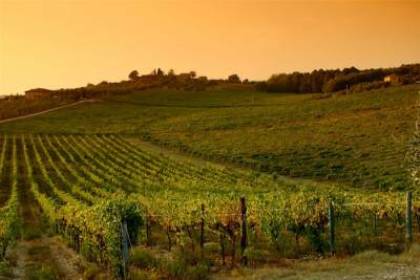
 In the Chianti hills
In the Chianti hills

filled by Giulia

Shades of green and red hues of the Tuscan countryside, the grade of red in the bottle.
A range of colors will surprise the visitor on their arrival, Italian and foreign. The British love it and have renamed Chiantishire like a county of old England. While Germans even more chic often called Cianti, with their proverbial tough pronunciation.
The first Chianti vineyards appear at Poggibonsi and appear in the middle of them unfolds the roads that seems to take you in paradise: it is the Chiantigiana way, in fact, that runs between the hills and hillocks, houses and castles, medieval villages closed in the ancient city walls , olive groves, cypress trees and spots of forest.
And of course, vineyards, lots of green vineyards. The secret of the world's most popular red wine is everything in these slopes, and in this land of sandstone and limestone, but also sand and clay. In the Chianti region, east of Poggibonsi, find, for example, the fortified little town of Castelnuovo Berardenga, a must for lovers of wild boar sausages and hams. Not far away is Castellina in Chianti, the center-profile Renaissance placed on 578 meters and open valleys of the Arbia and Pesa, which offers a wide view of the countryside, rich in castles and country houses. To the east, along the main road of the Val d'Elsa, meets Radda in Chianti: a town devoted entirely to wine, which preserves parts of the medieval walls and the elliptical map, and just outside the walls, the beautiful convent of Santa Maria in Prato, where shines the Madonna and Child painted in 1474 by Neri di Bicci.
Moving between rows of vines and cypresses we arrive in Gaiole, near which is what was the Abbey of San Lorenzo in Coltibuono, where, instead of Vallombrosa monks, wine experts now operates a modern company. Greve in Chianti, however, is a small town in the heart of the region characterized by the ancient triangular square and softly nestled in a green valley, surrounded by small medieval villages and lonely churches. In San Casciano Val di Pesa, there are two masterpieces of Italian art: a wooden Crucifix by Simone Martini and Lorenzetti's beautiful Madonna and Child. Marches on the edge of the circuit is finally Barberino Val D'Elsa, which curiously is split in half: one side has had the honor of being included in the Chianti area. In all, nine municipalities that a ministerial decree inserted in the magic circle.
Where to taste:
-In Gaiole in Chianti, winery Castello di Ama
Castelnuovo-Berardenga from Dievole
Where to eat:
Cintoia Bassa Osteria Locanda Tre Castelli (menu from Eur 35,000)
Greve Ristorante Residence hotel Casprini at Omero (menu from Eur 35,000)
For those who want to find everything must go to Siena, to the Enoteca Italian: Fortezza Medicea I, phone 0577288497. In the city center, this winery was founded in 1950 and focuses interesting thousand labels.
And for those who want to surf in the web... www.chianticlassico.com
In the photo Fattoria di Monaciano (www.monaciano.com)
|
|
 |






















